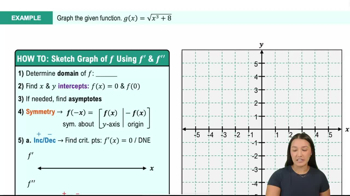Table of contents
- 0. Functions7h 52m
- Introduction to Functions16m
- Piecewise Functions10m
- Properties of Functions9m
- Common Functions1h 8m
- Transformations5m
- Combining Functions27m
- Exponent rules32m
- Exponential Functions28m
- Logarithmic Functions24m
- Properties of Logarithms34m
- Exponential & Logarithmic Equations35m
- Introduction to Trigonometric Functions38m
- Graphs of Trigonometric Functions44m
- Trigonometric Identities47m
- Inverse Trigonometric Functions48m
- 1. Limits and Continuity2h 2m
- 2. Intro to Derivatives1h 33m
- 3. Techniques of Differentiation3h 18m
- 4. Applications of Derivatives2h 38m
- 5. Graphical Applications of Derivatives6h 2m
- 6. Derivatives of Inverse, Exponential, & Logarithmic Functions2h 37m
- 7. Antiderivatives & Indefinite Integrals1h 26m
- 8. Definite Integrals4h 44m
- 9. Graphical Applications of Integrals2h 27m
- 10. Physics Applications of Integrals 2h 22m
5. Graphical Applications of Derivatives
Curve Sketching
Problem 26
Textbook Question
Use the guidelines given in Section 4.4 to make a complete graph of the following functions on their domains or on the given interval. Use a graphing utility to check your work.
ƒ(x) = 3x/(x² + 3)
 Verified step by step guidance
Verified step by step guidance1
Identify the domain of the function \( f(x) = \frac{3x}{x^2 + 3} \). Since the denominator \( x^2 + 3 \) is always positive for all real numbers, the domain is all real numbers.
Find the intercepts: For the y-intercept, set \( x = 0 \) and solve \( f(0) = \frac{3(0)}{0^2 + 3} = 0 \). For the x-intercept, set \( f(x) = 0 \), which implies \( 3x = 0 \), so \( x = 0 \). Thus, the intercept is at the origin (0,0).
Determine the asymptotes: Since the degree of the numerator is less than the degree of the denominator, there is a horizontal asymptote at \( y = 0 \). There are no vertical asymptotes because the denominator \( x^2 + 3 \) never equals zero.
Analyze the first derivative \( f'(x) \) to find critical points and determine intervals of increase and decrease. Use the quotient rule: \( f'(x) = \frac{(x^2 + 3)(3) - 3x(2x)}{(x^2 + 3)^2} \). Simplify and solve \( f'(x) = 0 \) to find critical points.
Analyze the second derivative \( f''(x) \) to determine concavity and points of inflection. Use the quotient rule again on \( f'(x) \) to find \( f''(x) \), and solve \( f''(x) = 0 \) to find points of inflection. Use this information to sketch the graph, and verify with a graphing utility.
 Verified video answer for a similar problem:
Verified video answer for a similar problem:This video solution was recommended by our tutors as helpful for the problem above
Video duration:
13mPlay a video:
Was this helpful?
Key Concepts
Here are the essential concepts you must grasp in order to answer the question correctly.
Function Analysis
Function analysis involves examining the properties of a function, such as its domain, range, intercepts, and asymptotes. For the function ƒ(x) = 3x/(x² + 3), understanding where the function is defined and how it behaves at critical points is essential for graphing it accurately.
Recommended video:

Derivatives Applied To Velocity
Graphing Techniques
Graphing techniques include methods for plotting functions accurately, such as identifying key points, using symmetry, and recognizing asymptotic behavior. For ƒ(x) = 3x/(x² + 3), determining the x-intercept and analyzing the end behavior will help create a complete graph.
Recommended video:

Graphing The Derivative
Use of Graphing Utilities
Graphing utilities are software tools or calculators that assist in visualizing functions. They can provide a quick way to verify the accuracy of a hand-drawn graph by showing the function's behavior over its domain, which is particularly useful for complex functions like ƒ(x) = 3x/(x² + 3).
Recommended video:

Graphing The Derivative

 11:41m
11:41mWatch next
Master Summary of Curve Sketching with a bite sized video explanation from Callie
Start learning




